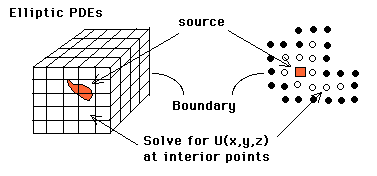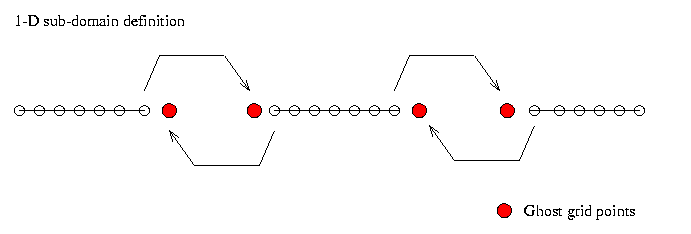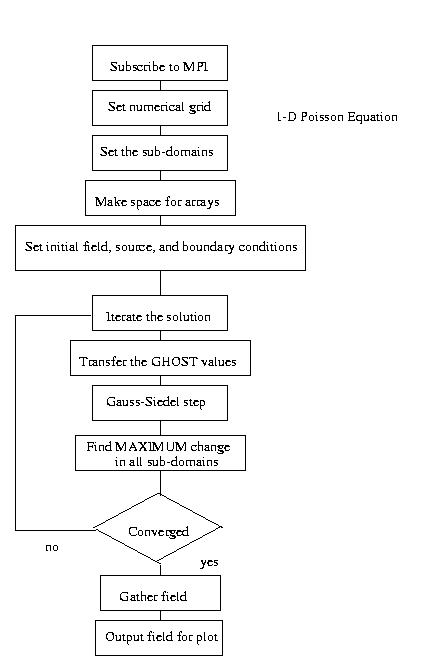Partial Differential Equations (PDEs) are encountered in virtually all of sciences, engineering disciplines and even in the world of business. We now want to devise a way to implement the solution of these equations on parallel computers. This leads to domain decomposition.
The numerical solution of PDEs almost always imply a numerical lattice to describe the domain over which we seek a solution. A natural (and often the only) way in which to render parallel the task of solving PDEs is to parcel the global domain into sub-domains and to let each processor of the parallel computer handle individual sub-domain; this is domain decomposition.
Note that in solving the so-called trivially parallelizable problems on parallel computers, i.e., the The Mandelbrot Set, the difficulty comes in ensuring load balancing; there is typically little node-to-node message passing. In domain decomposition, just the opposite occurs: minimization of communication is the major hurdle against achieving an efficient parallel code. Load balancing issues occur mostly due to complicated geometry.
We will next review (again) the classification of PDEs and mention the appropriate domain decomposition in each case. We will then describe briefly the implementation of domain decomposition on parallel computers.
PDEs are traditionally classified into three broad categories: elliptic, parabolic and hyperbolic equations. However, from the numerics point of view, PDEs divide into static equations (elliptic) and time dependent equations (parabolic & hyperbolic).
The prototypical elliptic equation is the Poisson equation
![]()
where ![]() is the
field (potential) we look for and the term
is the
field (potential) we look for and the term ![]() represents a source term. This equation is encountered in electrostatic,
gravitation, ect. The solution is static (time independent) and requires the
specification of
represents a source term. This equation is encountered in electrostatic,
gravitation, ect. The solution is static (time independent) and requires the
specification of ![]() in a 3-dimension manifold
in a 3-dimension manifold ![]() ,
subject to boundary conditions.
,
subject to boundary conditions.

The simplest domain decomposition consists in decomposing the cubic domain into smaller cubes equal in number to the number of processors. The difficulty, as far as load balancing is concerned, arises if the domain is not a cube. Think of what you would do if the domain would be rectangular, or worse of arbitrary shape! The amount of computing to handle each sub-domain obviously depends on the number of lattice points in the sub-domains, an equal number of lattice points in each sub-domain being necessary for load balance...
The hyperbolic and parabolic equations are quite different in that they represent initial value problems. Namely, the wave equation (hyperbolic)
![]()
(v=constant is the velocity of the wave propagation) and the diffusion equation (parabolic)
![]()
(D is the diffusion coefficient) are such that we ask for what is the
value of the field (wave) ![]() at a later time t knowing the field at an initial time t=0
and subject to some specific boundary conditions at all times.
at a later time t knowing the field at an initial time t=0
and subject to some specific boundary conditions at all times.
In this case, the domain decomposition applies to the space variables.
The time evolution is essentially sequential, ![]() is obtained from
is obtained from ![]() ,
which can not be parallelized. This is also true in obtaining a solution of ODEs.
,
which can not be parallelized. This is also true in obtaining a solution of ODEs.
Domain decomposition is implemented on a parallel computer by letting each processor handle a sub-domain (or at most a few sub-domains). Therefore the choice of these sub-domains becomes crucial in obtaining good performance. The strategy in choosing the sub-domains must be guided by the following requirements:
The load balancing is often easy to achieve if the geometry of the domain is simple, i.e., cubic, rectangular, ... These domains naturally lead to the same number of lattice points in each sub-domain. If the domain is irregular, the solution is often to "pad" the domain into a regular one, or sometimes to "linearize" the mesh points accessing scheme (done in finite element approaches). This leads to complications and inefficiencies in the implementation; we will not discuss this problem further here. We will assume a simple geometry in what follows.
The minimization of node-to-node communication is the major bottleneck in domain decomposition. The problem stems from the calculation of derivatives in finite-differencing schemes (same applies to finite-element approaches). Consider the 3-point forms for the first and second derivatives of a function:
![]()
and
![]()
In domain decomposition, each sub-domain is handled by different processors. At the boundary of the sub-domains, the value of the field at the neighbor points on the lattice reside in the local memory of the processors handling the adjacent sub-domains; this requires communication in the calculation of the derivatives.
Each sub-domain (at each time step) therefore becomes a mini-problem to solve; this mini-problem is of the same type as the larger problem, but with boundary conditions defined by the value of the field in the neighbor sub-domains. A two dimension problem looks schematically as:
The implementation of the domain decomposition algorithm only requires the MPI calls we have seen in the previous sections, yet book-keeping considerations can become quite complicated to implement in higher dimension problems.
In this section we solve Poisson equation in 1-D as a simple example of domain decomposition. The distribution of sub-tasks among the processes is typical of what is done in most parallel implementation of parallel equations solvers.
We will solve the equation
d2 j(x) / dx2 = s(x)
This function j(x) could represent the electric potential due to a charge distribution s(x), or the steady state temperature profile in the presence of a heat source s(x). The domain is 1-D, x within [ 0 , 1 ]. The boundary conditions are assumed of Dirichlet type, namely j(0) and j(1) are given. In addition, the function j(x) can also be specified on specific points in the interior domain. The source is also given, taken to be a simple gaussian centered at mid-point in what follows.
The domain is discretized on a 1-D numerical lattice, with xi = (i-1) h, h = 1.0 / ( N - 1 ), and where N is the number of grid points. The Poisson equation is re-written in terms of finite difference form
( j
i+1 - 2 j i + j i-1 ) / h2 = S i
This leads to a large set of linear equations to solve for j i , the field values on the grid, in the domain, keeping j i fixed at the boundary. This set of equations can be solved by an iterative method, whereby
j i = 1 / 2 ( j i+1 + j i-1 - h2 S i)
is iterated "in place" until the changes in j i become less than some predefined tolerance criteria. An arbitrary guess for j i is assumed to start with. The method is stable in that the solution will converge. The old and new values of j i are mixed to accelerate the convergence, leading to the "over relaxation" scheme. The accuracy of the solution is second order in h.
The code poisson_1d.c implements the above scheme. The steps in the code are:
The code, poisson_1d.c, is compiled and executed
gcc poisson_1d.c -lm -o poisson_1d
poisson_1d 5000 100 > solution_1d.dat
where 5000 and 100 are the (arbitrary) maximum number of iterations and number of grid points respectively. The code stops once good convergence ( parameter EPS ) is obtained. Use gnuplot to graph the solution.
Note:
Domain decomposition consists in dividing the original grid among the processes with an equal number of grid points in each process for good load balance. If the number of grid points does not divide equally among the processes, the extra grid points are distributed one each to a subset of processors as indicated schematically in the following figure.

This results in the following arrangement on each processor

The calculation of the derivative terms in finite difference scheme requires the field values at neighbor grid points to be known. Therefore, the value of the field at the artificial boundary between sub-domain must be transmitted between the neighbor processes as indicated in the figure. This must be done at each iteration during the calculation, leading to much transmission.
There are many issues involved in setting up a parallel code to solve PDEs. Here are some of the most important ones:
The flowchart of the parallel code is given below:

The parallel code, poisson_parallel_1d.c, is compiled and executed via the same commands as the serial code:
mpicc poisson_parallel_1d.c -lm -o poisson_parallel1d
mpiexec -np 4 poisson_parallel_1d 5000 100 | > data_parallel